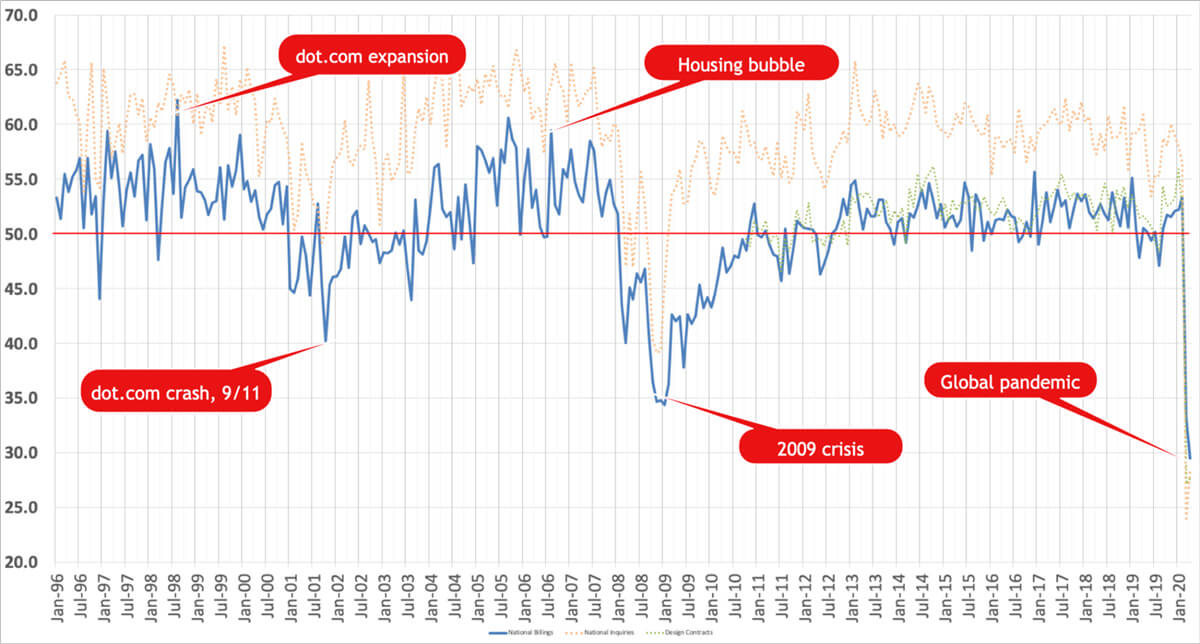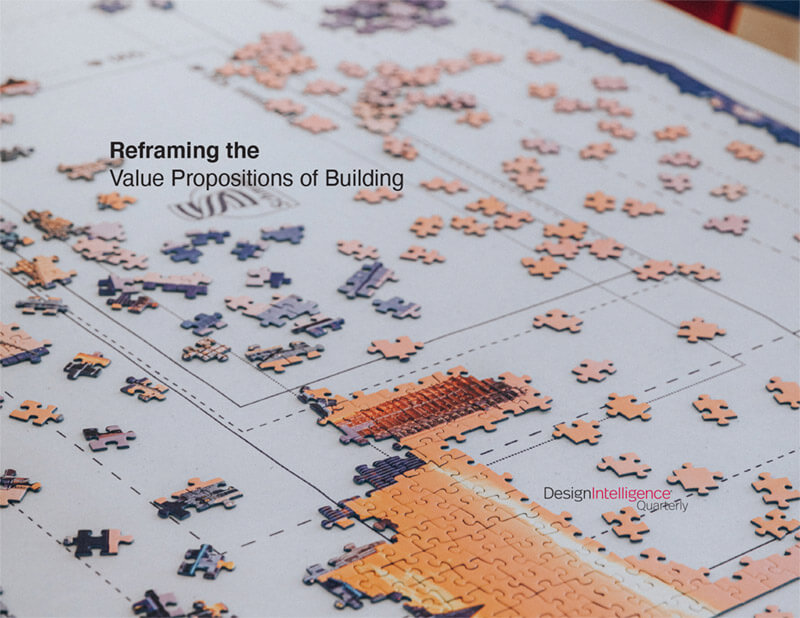Reframing the Value Propositions of Building
by Phil Bernstein
Associate Dean & Professor Adjunct at the Yale School of Architecture
Phil Bernstein investigates agency, project delivery, and building performance as future value proposition paths
In February of this year, I gave my annual lecture to our students about the economics of the architecture profession, a traditional kick-off to our spring career development festivities. More than sixty firms had signed up to interview our seventy-odd soon-to-be graduates after the March break. Updating my slides from the previous year, and with all indicators looking just fine, I suggested to our troops that while our industry was past the usual deadline for a recession (on the usual seven-ish year cycle) there were no ill signs on the horizon. I projected a graph of the history of the Architectural Billings Index since 1996 that showed the ups and downs in the building economy including the dive of 2009, and I intoned that “while you will probably see several recessions during your career, the 2009 crisis was a once-in-a-generation aberration.” If only.
By March, that graph looked awful, with the lowest ABI data ever recorded. April was even worse:

I had to change the scale to make the rapidly descending data fit — needless to say, a catastrophe. Sign-ups for our recruiting event, transfigured over spring break to a virtual affair, deteriorated accordingly. A third of the firms said they were still hiring, another firm “weren’t sure” but offered “informational practice interviews,” and the last group disappeared from the radar completely, unresponsive to our queries. A proxy, perhaps, for the potential future of the profession writ large.
Those of us of a certain age have seen many of these oscillations in the building industry’s economic curve. I started my career out of college during the 1979 energy crisis (Carter), left graduate school to join the 1983 savings and loan downturn (Reagan), survived the jobless recession of 1990 with a job (Elder Bush), and lived in the corporate world during the dot-com crash of 2002 (Younger Bush) and the housing collapse of 2008 and 2009 (Younger Bush again, passed along to Obama). One would think that repetition yields wisdom, but I can’t say with certainty that our profession takes any particular lessons from these existential perturbations.
Perhaps the greatest missed opportunity was 2009, a recession during which the structural and performative challenges of architecture and building were clearly understood, and most of the economy had turned to digitally driven productivity growth, with the notable exception of building. This graph, produced by McKinsey Global Institute, tells that story well:
The Information/Communication/Telcom sector (“ICT”) in the upper right corner of this correlation of digitization and productivity sets the pace at 3.5% growth and 93% digitization.
Construction is at the opposite end, with negative growth and anemic digitization, wrapping the entire missed opportunity in a neatly correlated diagnosis. Related symptoms include commoditized pricing yielding thin margins, low expectations of quality and service, the near impossibility of precision pricing and schedule conformance, labor challenges, ambiguous distribution of responsibilities, and a lousy risk/return ratio.


The implications of the pandemic for the built environment have not yet come into view, and likely will not do so for many months to come. What is apparent from this side of the epidemiological and economic abyss, however, is that the responsibilities of architects and architecture will be reframed in significant ways:
- Abandoned space made redundant by home working and business failure must be repurposed; the role of buildings that instantiate economic and social inequality examined and redefined; the relationship of those buildings to public infrastructure like transportation rethought;
- the contributions of building to global warming reduced;
- the health implications of building occupancy understood and optimized;
- the definition of the public’s health, safety and welfare, the raison d’etre for licensure, questioned and potentially refactored.
We should admit that we largely wasted the last crisis. Perhaps now, with the building industry facing its most dramatic survival challenge since the Great Depression, we can reframe our processes and results and exit this crisis resolved to change building in a real way. Doing so means examining and reframing three essential elements of the industry value proposition:
- agency (the roles and responsibilities of designers and builders as they deliver projects)
- project delivery strategy (the relationships of the demand, design and construction elements of the supply chain that actualize buildings), and finally
- building performance (how buildings work during their lifecycles rather than how closely they adhere to objectives of cost, schedule, and putative quality).
In doing so we might shift our attention from small-bore experimentation with tactics to a radical shift in the value propositions of design, construction and operations.
Reframing Agency
The dis-integration of the building supply chain is a well-understood phenomenon that traces its roots back to the original distinction of design as separate from construction (Alberti, in the Renaissance) through the professionalization of the practice of architecture in America during Reconstruction, and then the liability crisis of the 1980s. The first two decades of the twenty-first century saw further dispersion of responsibility and control as the technical complexity of building began to far exceed any entity’s ability to singularly understand, much less comprehensively control it. The romantic ideal of the “Master Builder” is compelling but utterly obsolete in a world where even the simplest construction project involves hundreds of people, from designers, contractors, on-site construction workers, inspectors, funders, and building product manufacturing personnel and supply chains stretching across the world.
A return to the notion of Master Builder is not the answer to the problems in buildings that result from the disaggregation of process, nor will it address consistently poor outcomes in our industry. The desire itself signals a wrong-headed strategy for a solution that conflates power and control with results. I am reminded of some of the early days of building information modeling (BIM) as we worked on the argument for its implementation. Leaders in the industry associations of architects and builders each told me, when not in the company of the others, that BIM was the tool that would finally allow them to wrest control of the process away from their perceived adversaries. Architects hoped the power of information would ensure that contractors met their design ends; builders were sure that BIM would obviate the need for nettlesome architects, and so on. Needless to say, this was neither an effective nor particularly efficient approach, since it failed to get to the root of the problem: the lack of useful, precise information to support proper decision-making. Controlling a decision is not the same as making a good decision.
Generating, delivering, and deploying that information effectively is not improved by increasing the control of its creation and management. Rather, it is enhanced by empowering its creators to work toward goals that support overall project objectives, be they cost conformance, design excellence, schedule control, or building quality. In today’s approaches, the acts of creating and consuming those data are a function of heavily commodified business transactions. These exchanges constrain the agency of designers to explore problems deeply, builders to define their information requirements necessary to build effectively, and ultimately, owners to generate goals that can drive all the players toward agreed-upon ends. This is a topic suited to a much broader exploration than can be accommodated here, so let’s examine this question from the perspective of designers as an example of how models of agency might be re-examined in a post-pandemic world with different building expectations and demands.
George Johnston, in his recent insightful examination of the history of the profession Assembling the Architect: The History and Theory of Professional Practice, traces the precise arc of how the American architecture profession, wrestling with the emergent discipline of general contracting at the turn of the twentieth century, defined our role as “agents of the Owner” in the constellation of delivery, largely in an attempt to take the side of the gentlemen class rather than the mechanics. In doing so, architects aligned themselves in opposition to builders (who were convinced architects wanted too much control in any case). The unintended consequences of this approach can be seen in today’s practice. Combined with the traditions of lowest first-cost fees, this putative “agency” operates in three modalities: defining the “design intent” of the ultimate construction result; assuring, in a limited fashion, that the builder adheres to said “design intent,” and protecting the public’s health, safety and welfare.
Each component bears re-examination in post-pandemic construction, starting with the deliverables of design intent, most clearly manifest in the traditional working drawings that are the primary vector of the architect’s decisions pointed at the contractor (through the contract for construction with the owner). Much as performance-based specifications made early attempts to define what a construction assembly should accomplish (rather than specifying exactly what it should be), technology today can, through robust digital modeling, simulation and analysis, become more projective about the end state of building. A more modern and effective revision of the concept of working drawings might be less about the graphical representation of the abstract state of a completed building, and more infused with performative and instructive data about how that building might work and be assembled based on highly resolved predictive models of the design itself. Doing so means delivering much higher value to both the builder and the client than is possible through orthographic drawings and is a lever point to redefine the potential risks and return of the design proposition.
Many things about the architect’s responsibility likely change as a result. A good example is the vaguely understood process of “construction observation.” This evolution of the architect’s nineteenth century role as construction coordinator (as described by Johnston) has morphed into today’s risk-averse responsibility to “generally assure conformance to the construction documents.” Is it possible that the architect, as the party primarily responsible for a robust digital “prediction” of a performing building, could more usefully collaborate with a competent building toward better ends — technically, aesthetically, and epidemiologically?
Which raises a second, and potentially more existential, possibility. In a world where global warming, social inequity, and repeated pandemics are intimately bound with building, questions of public health, safety, and welfare — and the architect’s responsibility for them all — arise with new urgency. As society re-examines the role and meaning of building in addressing these questions, architects could consider broadening our responsibilities in answering those questions. Doing so would deploy our design skills in addressing the core problems facing society, create new contexts for the creation and use of our design information, make licensure even more relevant, and perhaps finally push us out of the inexorable orbit around the fixed-fee, low-margin sun.
Reframing Project Delivery Strategy
A change in the roles and responsibilities of architects cannot occur, however, in a supply chain vacuum. This suggests that the underlying principles and structures of project delivery must be re-examined, delaminated, and potentially redefined. But the roots of those systems run very deep in the history and psyche of the American building industry.
Johnston suggests that the basic diagram of delivery — architect designs, contractor bids, owner selects, construction commences — was the de facto delivery model from Reconstruction through the expansion of the U.S. in the early twentieth century, refined by the evolution of professional standards and prototype contractual models generated by the competing constituents of design (the AIA) and construction (various contractor associations). It was only in the latter decades of the twentieth century that other modalities — construction management, design/build — were defined and emerged as canonical approaches supported by standard contracts and other protocols. By the early 2000s, an increasing dissatisfaction with the risk/return equations of building combined with the collaborative possibilities of BIM catalyzed the integrated project delivery movement, and with it another typology, IPD. Almost twenty years later, however, IPD remains a provocative but largely ignored option to deliver a project.
The pandemic creates a breach into which new delivery approaches, driven by the current extensive investment in so-called BuildTech, may step. A combination of economic pressure created by reduced demand for building (and potential over-supply of construction capacity), combined with the deterioration of the construction labor workforce (due to health and immigration constraints) will force construction toward automation, industrialized processes, and pre-fabrication. BuildTech companies will supply tools driven by computer vision, big data, high resolution data collection through sensors and drones, and artificial intelligence and machine learning. The inputs for such systems should originate with design data created by architects, first as geometry and perhaps in the future with integrated DFM (design-for-manufacturing) deliverables. The definition of construction documents is likely to evolve significantly as a result.
But rather than whole new delivery systems emerging to accommodate these emergent obligations, the industry will likely move to episodic, rather than wholesale, integrative approaches. This can already be seen in new companies big (WeWork, Katerra) and small (Blockable, Skender) who are crossing single barriers of the design/build/deliver supply chain. High resolution information and assembly automation make these opportunities possible. IPD may have established the broad principles under which some of these relationships may develop, but it’s more likely that value will be created at a smaller scale in episodes in the supply chain. Designers can provide the information that is the binding agent of many of the resulting transactions.
Reframing Building Performance
Questions of agency and delivery are the supporting cast in the larger opportunity for reframing the value of the design and construction process, however. Right now, each is circumscribed by the mismatch between the reasons clients build buildings and the methods by which they obtain those buildings. Lacking a common understanding of how to organize and optimize the delivery of a building, process is driven by a desire to accomplish lowest first cost. But owners do not build to save money, but rather to make things happen: deliver services, provide productive workplaces, educate children, and make people healthier. They just want to spend a reasonable amount of money to do so. In a post-pandemic world, we must add “keep occupants healthy and safe” to that list.
Building process could be focused on these objectives rather than lowest price: measuring the success and value of a building based on how it actually performs, rather than what it costs and how long it took to deliver (two goals rarely met today). I have defined such objectives in a hierarchy of performance value, where the base of the pyramid is improving the efficiency of the building process, and the top displays the highest-order objectives clients need their buildings to fulfill:

Changing the agency of architects and builders and refactoring the systems in which they exercise this agency, is only interesting when the delivery system is predicated on a process where buildings are created to actually do things (perform), rather than being consumed as commodities. The risk of the enterprise becomes the risk that the building doesn’t actually do the things asserted by its designers and builders; but the return is the willingness of clients to pay for those sorts of results.
A building is a form of social contract between its owner and its occupants, and the citizens of the neighborhood or city where it is created. In exchange for the privilege of absorbing resources, space, and the opportunity cost of an alternative, buildings should serve to improve the social conditions in which they exist. This is a form of performance that, should architects choose to deploy the necessary tools and learn to do so, could transform the entire enterprise of building.
The Future Value Propositions of Building
It seems that my upcoming summer will be spent in full-blown pandemic planning mode as architectural education, much like the profession itself, readies itself for the uncertainties of the future. We are relying on our skills as architects to prepare for the resulting contingencies, studying (with the help of detailed BIM datasets and simulation tools) the occupancy, configuration, circulation, and air dynamics of our spaces. In collaboration with colleagues from the Schools of Medicine, Nursing and Public Health we combined our architectural expertise to fully understand the potentials and future uses of our buildings under radically new circumstances. Forced into new ways of thinking, analysis, and collaboration to face new realities we are cautiously optimistic that our pedagogy will be different, but equally effective under these new circumstances.
As we stare down the convergence of three simultaneous crises — a fractured economy, a global pandemic, and social unrest connected to Black Lives Matter — those of us who design and build might feel peripheral to the key issues of the day. Nothing is further from the truth. To make such a conclusion is to deny the central value of the built environment in answering each of these questions — and the skills building professionals can bring toward real solutions. Buildings are the platforms that house our economic engines. They constitute the physical context in which social equity can be reached (or destroyed). They mediate our relationship with the environment, epidemiologically or otherwise.
Perhaps this particular crisis, unlike its predecessors, will inspire us to acknowledge the shortcomings of our current protocols and design a future for the built environment that the world truly deserves.
Phil Bernstein is Associate Dean and Professor Adjunct at the Yale School of Architecture, where he has taught since the 1989 recession. He was formerly a vice president at Autodesk, and principal at Pelli Clarke Pelli Architects. He writes, lectures and consults frequently on technology strategy, project delivery and design agency, and is a Senior Fellow of the Design Futures Council.


